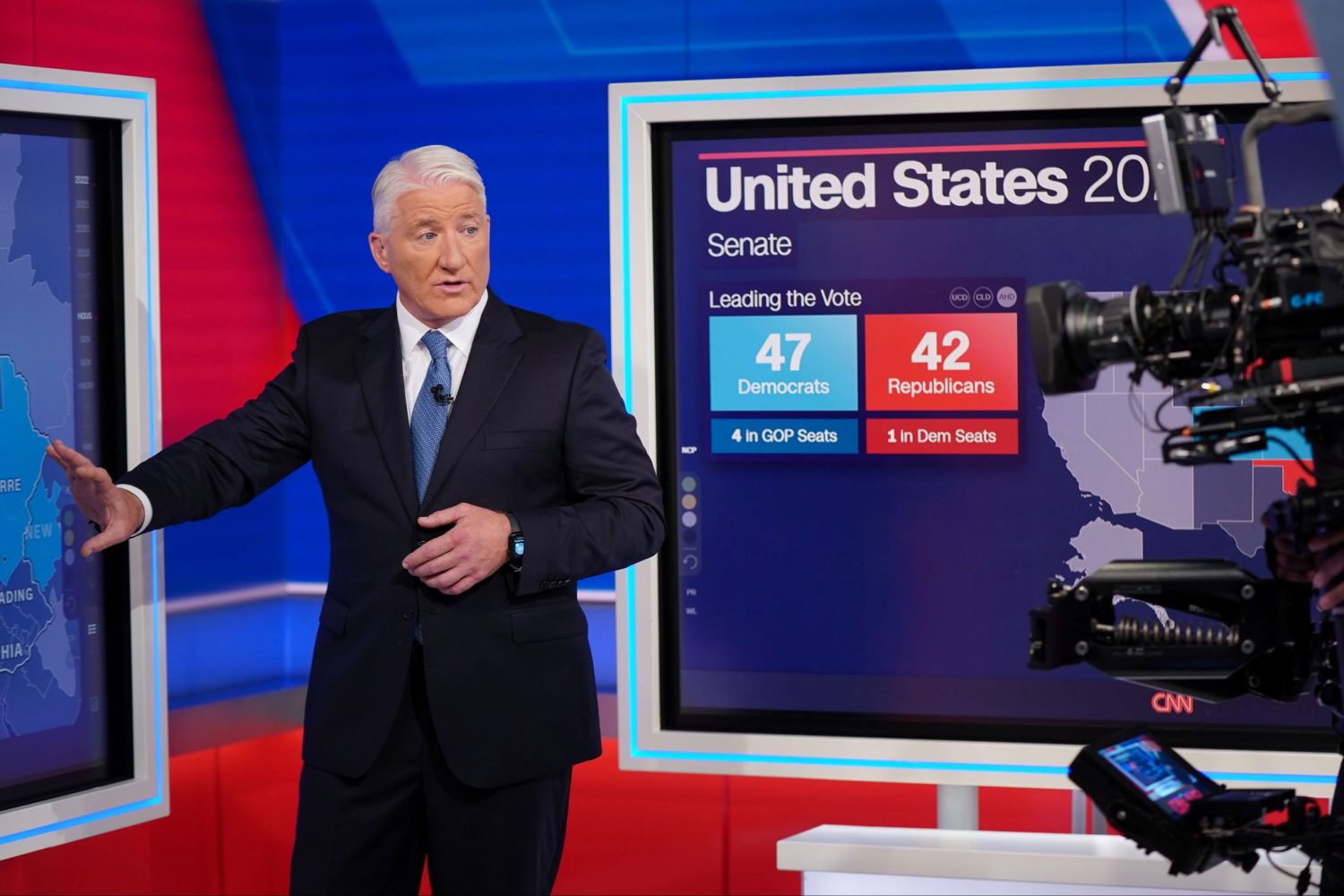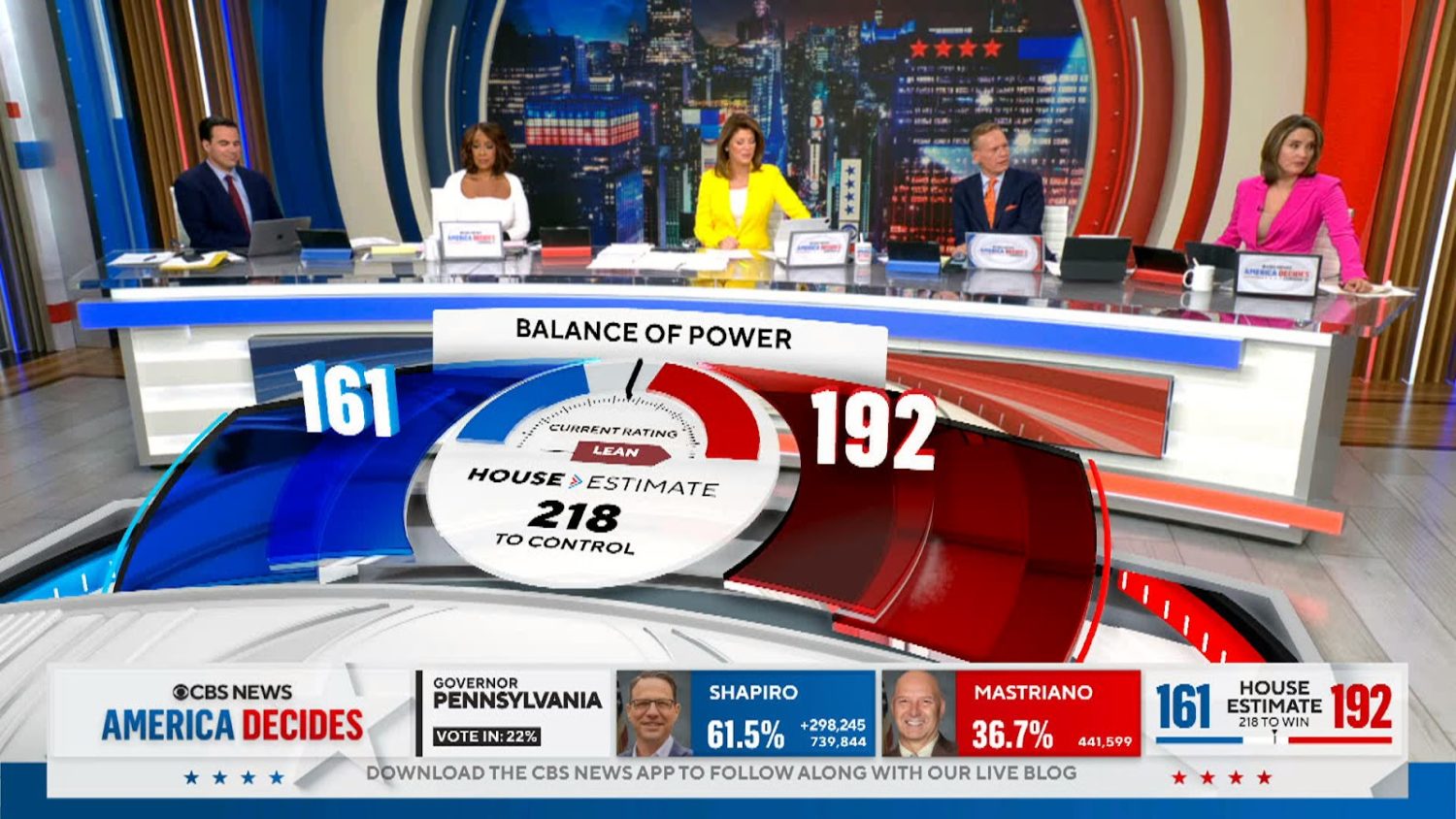The United States might be spectacularly divided when it comes to our politics, but there’s one thing we all should agree on: media coverage of our elections is outstanding.
Tuesday night’s coverage, particularly on TV, was top-notch.
ABC, CBS, NBC, PBS and the cable news networks, particularly MSNBC, all provided Americans with coverage that was long on analysis and reporting and properly short on hyperbole and speculation.
The coverage, of course, is not over. Votes are still being counted. As expected, Election Day will turn into Election Week.
But looking at Tuesday night, the big winner was TV viewers. Here’s a look at some of the highlights, with much more coverage coming in the days ahead.
A MESSAGE FROM OUR SPONSOR

Local news is disappearing: Students can save it
Local news is a trusted source of critical information. Hundreds of colleges and universities have found ways to support community news – teaching students to report on their communities, and collaborating with local media.
Interested? Join other colleges in making local news stronger. Bring your students to the table.
Are you a journalist? Would you like to explore a partnership with a local college and not sure where to start?
Star of the night

MSNBC’s Steve Kornacki, in front of his big map during Tuesday’s election coverage. (Photo courtesy of MSNBC)
As always, MSNBC’s Steve Kornacki, with his big map, was a must-see every time he was on the screen. Not just because he had the latest numbers, but because he had all the trends. I talked to Kornacki back in August about how he was preparing for Tuesday night, and he went through how he studies up on all the nuances in the pivotal counties that help determine elections. For Kornacki, Tuesday was a culmination of months and even years of preparation and experience.
Kornacki was at his best Tuesday when looking at races in Pennsylvania and Georgia, comparing this year’s critical Senate races to how Joe Biden and Donald Trump fared in 2020. Kornacki also showed the gaps between how the senatorial candidates compared to the gubernatorial candidates of the same party.
For example, the numbers were showing that Georgia GOP senatorial candidate Herschel Walker and Pennsylvania Democratic candidate John Fetterman were both not performing up to the levels of the governor candidates of the same party. That showed how voters — particularly Democrats in Pennsylvania and Republicans in Georgia — might have been splitting their votes. He was just as good when his MSNBC colleagues threw him questions, quickly coming up with answers and easily adjusting his analysis.
He also was especially impressive when talking about how Mehmet Oz, who is running against Fetterman, wasn’t meeting the Trump 2020 numbers in Pennsylvania — numbers that weren’t good enough to win the state. His several-minute breakdown gave an early preview of how the hotly-contested Pennsylvania vote would turn out.
And his breakdown of the House races just before midnight was spectacular. MSNBC’s Chris Hayes said, “That was remarkable. I don’t think I know anything in the world as well as Steve knows the House races.”
Even when he wasn’t talking, MSNBC used a “Kornacki Cam” to let viewers know that he was hard at work. A “Kornacki Cam?” You gotta love it.
King of the maps

CNN’s John King, during Tuesday night’s election coverage. (Photo courtesy of CNN)
While Kornacki is always superb, it should be mentioned that CNN’s John King and his big map also are worthy candidates as the stars of the night. Like Kornacki, King is fast on his feet and expertly can break down races by using recent voting history and his experience to give viewers a look at what is happening in real-time and how it could play out over the rest of the night. A good example of King’s work was this piece in which he explained how competitive House races can predict a red or blue wave.
With seemingly a million races to track and voting numbers coming in at a dizzying and relentless pace, Kornacki and King were never rattled, were always sharp, and everything they said armed viewers with more knowledge.
DeSantis vs. Trump

Fox News’ Bill Hemmer during Tuesday night’s election coverage. (Photo courtesy of Fox News)
Former President Donald Trump, who is rumored to be close to announcing that he will run for president again in 2024, seems to know that his biggest Republican challenger might be Florida Gov. Ron DeSantis, who easily won re-election on Tuesday. Trump showed his hand by going to his playbook of making fun of someone’s name. He called DeSantis “Ron De-Sanctimonious” at a recent rally.
Early Tuesday evening, Fox News senior political analyst Brit Hume said, “We’ve got this brewing competition between Mr. Trump and Gov. DeSantis, which has been obvious in the last couple days. If it’s a big, big night for DeSantis and his running mates in Florida, that would sharpen that competition a bit and give Mr. Trump something to think about.”
Turns out, it was a big night for DeSantis, and it does give Trump something to think about.
On NBC News, Chuck Todd made this interesting point: “If the Republicans only get the House by about 5 to 10 seats, (credit) Ron DeSantis — he jammed through a new House map. It gave them four House seats that they didn’t think they were going to have. Ron DeSantis might be the hero of the night for the Republicans, while Donald Trump might be the guy who suddenly spurred Democratic turnout.”
Todd also delivered what might have been the line of the night, shooting down the idea that it was going to be a huge night for the GOP. Todd said, “Look, I think it’s safe to say we’re not gonna have a wave, okay?”
Sen. Lindsey Graham, the Republican from South Carolina, told NBC News, “Definitely not a Republican wave, that’s for darn sure.”
Cool coverage
The Washington Post debuted its Elections Model page, with up-to-the-minute results of every House and Senate race, as well as a governors page. The Post also linked to races in all of the states. It’s well-designed and extremely informative. And another really good Post project: “Tracking which 2020 election deniers are winning, losing in the midterms.” At 11:30 p.m Eastern on Tuesday, the Post reported that more than 130 election deniers (out of 291) had won their midterm race.
Meanwhile, The New York Times brought back its Needle graphic, which shifts to and fro depending on projections of who will win control of the House and Senate. CNN’s Oliver Darcy accurately describes it as the “anxiety-inducing” needle. That’s accurate because of how those who followed the 2020 presidential election stressed over every subtle shift of the needle.
It’s also occasionally frustrating for readers when the Needle has to be shut down for a while, as it was Tuesday night. The Times ran a note that said, “We’re looking into an issue with our estimates in Louisiana. We plan to turn the needle back on soon.”
Again, that’s frustrating, but the right thing to do is to make sure the coverage and projections remain as accurate as possible, even if that means turning it off for a while. Besides, it wasn’t down for long and was a go-to resource all night long.
Opening remarks
Here were the opening remarks on the “NBC Nightly News” from anchor Lester Holt: “The stakes have rarely been higher in a midterm election, shaped by everything from inflation and reproductive freedoms to threats from violent crime and threats to our democracy. “
Good interview
“PBS NewsHour” anchor Judy Woodruff interviewed House Speaker Nancy Pelosi in a piece that ran Tuesday night before polls had closed. Pelosi warned that Republicans taking over the House could put Social Security and Medicare in jeopardy.
“Our challenge is we are not fear mongers,” Pelosi told Woodruff. “You don’t want to scare people, but you have to let them know what is at stake in the election.
Awesome video of the day
Check out this video shot by a drone that takes you behind the scenes at 30 Rock in New York — home for NBC News and MSNBC’s election coverage. Pretty cool stuff.
Not so cool video of the day
On Tuesday, Kari Lake, Arizona’s Republican gubernatorial candidate, had this ominous message to the media: “I’m going to do two terms. I’m going to be your worst frickin’ nightmare for eight years, and we will reform the media as well. We are going to make you guys into journalists again. So, get ready. It’s going to be a fun eight years.”
“Fun” doesn’t sound like the appropriate description for someone who threatens the media by saying she is going to be their worst nightmare. And, this, by the way, from someone who used to be a journalist.
Fox News’ John Roberts pushed back on air by saying, “I’m not quite sure what she was getting at there because … the rich history of a free press in this country is something we have embraced for many, many hundreds of years. So I’m not quite sure how a politician goes about reforming the media.”
Random media thoughts and tidbits about the election coverage
- It’s still a bit odd to see longtime Fox News newsman Chris Wallace on CNN. And we’re still getting used to seeing Kasie Hunt on CNN, too.
- Good news/bad news from a CNN voter exit poll on Tuesday. Roughly 8 in 10 of voters in this year’s midterms said they were at least somewhat confident that elections in their state are being conducted fairly and accurately. But about 7 in 10 feel that democracy in the country is somewhat or very threatened.
- MSNBC is seen as the network for “liberals,” but the coverage all night was outstanding. Besides Kornacki, the strong suit was panel discussions about issues. That panel, moderated by Chris Hayes, included former RNC chairman Michael Steele, former Missouri Democratic Sen. Claire McCaskill and MSNBC host Symone Sanders Townsend, who is the former chief spokesperson for Vice President Kamala Harris. And while Rachel Maddow is liked by liberals and loathed by conservatives, she does an outstanding job running an election broadcast, performing like a really good basketball point guard setting up the people around her while showing off her skills.
- Speaking of MSNBC, former Biden White House press secretary Jen Psaki was prominent on coverage Tuesday night, and she looks to have the potential to be a TV star.
Non-election notes, links and tidbits from Tuesday
- There are reports that Elon Musk is thinking about putting all of Twitter behind a paywall. Platformer’s Casey Newton first wrote about it. Newton, it should be noted, did write, “It could not be learned how serious Musk and Sacks are about the paywall; Twitter did not respond to a request for comment. It also does not appear imminent, as the Blue team is wholly occupied with the launch of expanded verification.”
- Speaking of Musk, The Atlantic’s Charlie Warzel writes, “Elon Musk Is Bad at This.”
- For the New York Magazine, Kerry Howley writes about the Britney Spears conservatorship in “House of Spears.”
- Variety’s Thania Garcia with “Drake and 21 Savage Sued for $4 Million by Conde Nast Over Fake Vogue Cover Used to Promote ‘Her Loss.’”
- World Series ratings are in and they were not great. The Houston Astros’ six-game series victory over the Philadelphia Phillies averaged 11.78 million viewers on Fox. That’s the second-lowest number since Fox started airing the World Series in 2000. If you count Fox, Fox Deportes and streaming, the number was 12.03 million.
More resources for journalists
- Subscribe to PolitiFact’s weekly newsletter. Get facts delivered straight to your inbox.
- Table Stakes: Poynter’s Local News Innovation Program (2023) — Apply by Nov 18.
- Honor free press, democracy and the distinguished careers of Bob Woodward and Carl Bernstein at Poynter’s Bowtie Ball. The duo will receive the Poynter Medal for Lifetime Achievement in Journalism with Carl Bernstein accepting the honor in-person on Nov. 12, 2022, in Tampa, Florida. Get tickets.
Have feedback or a tip? Email Poynter senior media writer Tom Jones at tjones@poynter.org.
The Poynter Report is our daily media newsletter. To have it delivered to your inbox Monday-Friday, sign up here.







